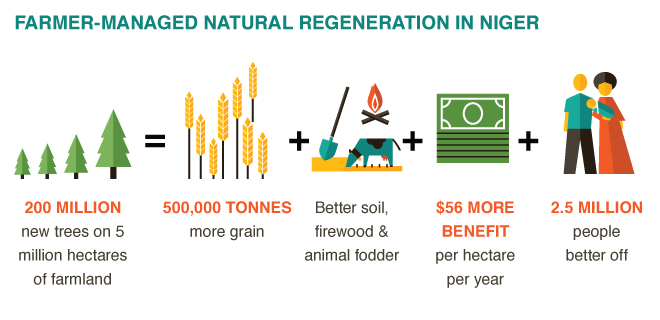Adaptation of Crops and Farming Systems

Facts
- Most adaptation options build on existing practices and sustainable agriculture, rather than being new technologies (Jarvis et al. 2011).
- Several adaptation options show promise for reducing negative (and increasing positive) impacts of climate change. A meta-analysis of the impact on yield between the adapted and non-adapted cases for rice, wheat and maize production is equivalent to about 15 to 18% of current yields. The yield benefits differ between crop species, region and the type of adaptation management option. But the average picture across multiple studies when comparing between adapted and non-adapted states suggests the following benefits: cultivar adaptation (23%); altering planting date in combination with cultivar adaptation (3 to 17%); optimising irrigation (3.2%); optimising fertilization (1%) (Porter et al. 2013).
- Mixed crop-livestock systems, if well managed, may be among the most promising means of adapting to climate change and mitigating the contribution of crop and livestock production to greenhouse gas emissions. Options include: integrated soil–crop–water management; improved water-use efficiency and management; sustainable soil management; improved feed management; and diversification of enterprises to form climate-resilient agricultural production systems (FAO 2013a p. 222).
- Information and communication technologies (ICTs) have the potential to help monitor climate change and to help farmers adapt to it and mitigate its effects. ICTs can help in the timely provision of climate-related information, which may allow vulnerable societies and individuals to prepare for extreme weather events. This can reduce losses during bad years but also allow farmers take advantage of favourable climatic conditions (CCAFS 2013).
- After nearly a quarter century of research, the International Center for Tropical Agriculture (CIAT) has succeeded in breeding drought-tolerant common beans. The new beans yield 600– 750 kg per hectare under severe drought, roughly double the maximum yield that Latin American farmers get from commercial varieties under the same conditions. Bean researchers are testing the new varieties in Central America and eastern Africa, and are crossing them with local cultivars to combine their drought tolerance with other traits that farmers need (CGIAR 2009).
- However, crop breeding—such as breeding beans for drought tolerance—may not be able to cope when climate change is associated with multiple, interacting environmental stresses (e.g. drought, heat and low soil fertility) (Beebe et al. 2008).
- Crop wild relatives can be used to improve climate tolerance in crops, but they are themselves under threat of extinction in the wild as a result of climate change (Lane and Jarvis 2007). These genetic resources are also under-represented in genebanks and poorly researched for use in crop improvement.
- Some plants and livestock breeds that are currently underutilized may become more attractive to farmers as a result of climate change. Many neglected and underutilized species that are currently maintained through in situ conservation could become important crops in the future. Empowering farming communities is essential for effective in situ conservation as this encourages local decision making on genetic-resources management (Sthapit et al. 2009).
- Climate change is expected to result in the emergence of new pests and diseases and changes in current disease and pest ranges. Strategies for dealing with this include adopting cropping systems that favour biological control; resistance breeding; cultural practices (e.g. crop rotation, intercropping, switching cultivars, reduced tillage and changes in planting time); and sound phytosanitary measures and quarantine regulations (Legrève and Duveille 2010).
Sources and further reading
- Beebe SE, Rao IM, Cajiao C, Grajales M. 2008. Selection for drought resistance in common bean also improves yield in phosphorus limited and favorable environments. Crop Science 48(2):582–592. (Available from http://dx.doi.org/10.2135/cropsci2007.07.0404)
- [CCAFS] CGIAR Research Program on Climate Change, Agriculture and Food Security. 2013. Farmers dial in for climate adaptation [webpage]. http://ccafs.cgiar.org/farmers-dial-climate-adaptation#.UiiQEMYmlJU (Accessed on 4 November 2013)
- CGIAR. 2009. Adapting agricultural systems to climate change. Briefing dossier for the CGIAR at COP15, December 2009. (Available from http://cgiar.bio-mirror.cn/impact/global/cc_adaptingagrsystems.html) (Accessed on 5 November 2013)
- [FAO] Food and Agriculture Organization of the United Nations. 2013a. Climate-smart agriculture sourcebook. Rome: FAO. (Available from http://www.fao.org/docrep/018/i3325e/i3325e.pdf) (Accessed 5 November 2013)
- Jarvis A, Lau C, Cook S, Wollenberg E, Hansen J, Bonilla O, Challinor A. 2011. An integrated adaptation and mitigation framework for developing agricultural research: synergies and trade-offs. Experimental Agriculture 47:185–203. (Available from http://dx.doi.org/10.1017/S0014479711000123)
- Lane A, Jarvis A. 2007. Changes in climate will modify the geography of crop suitability: agricultural biodiversity can help with adaptation. SAT eJournal 4(1) (Available from http://www.icrisat.org/journal/SpecialProject/sp2.pdf) (Accessed on 5 November 2013)
- Legrève A, Duveille E . 2010. Preventing potential disease and pest epidemics under a changing climate. In: Reynolds MP, ed. Climate change and crop production. Wallingford, UK: CABI Publishing.
- Porter JR, Xie L, Challinor A, Cochrane K, Howden M, Iqbal MM, Lobell D, Travasso MI. 2014. Food Security and Food Production Systems. In: Field CB, Barros VR, Dokken DJ, Mach KJ, Mastrandrea MD, Bilir TE, Chatterjee M, Ebi KL, Estrada YO, Genova RC, Girma B, Kissel ES, Levy AN, MacCracken S, Mastrandrea PR, White LL, eds. Climate Change 2014: Impacts, Adaptation, and Vulnerability. Part A: Global and Sectoral Aspects. Contribution of Working Group II to the Fifth Assessment Report of the Intergovernmental Panel on Climate Change. Cambridge and New York: Cambridge University Press. (Available from http://ipcc-wg2.gov/AR5/images/uploads/WGIIAR5-Chap7_FGDall.pdf)
- Sthapit B, Padulosi S, Mal B. 2009. Role of on-farm/in-situ conservation and underutilized crops in the wake of climatic change. Paper presented in the National Symposium on Recent Global Developments in the Management of Plant Genetic Resources, NBPGR, New Delhi, India,17–18 Dec. 2009.